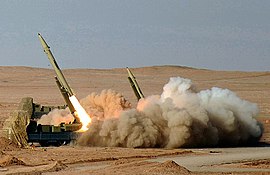| Fateh 110 | |
|---|---|
 Fateh-110s in Iran's "Great Prophet-7" military exercise, 2012 | |
| Type | Tactical SRBM |
| Place of origin | Iran |
| Service history | |
| In service | 2002–present |
| Used by | See Operators |
| Wars | Syrian civil war |
| Production history | |
| Manufacturer | Iran |
| Specifications | |
| Mass | 3,500 kg |
| Length | 8.90 m |
| Diameter | 0.60 m |
| Warhead | high explosive or submunition |
| Warhead weight | 500 kg |
| Engine | Single stage, solid fuel rocket |
Operational range | 300 km |
| Maximum speed | Mach 4 |
Guidance system | Inertial & electro-optical terminal (according to Iranian state media)[1] GNSS (according to Western analysts)[2] |
Launch platform | mobile launcher |
The Fateh-110 (Persian: فاتح-۱۱۰ "conqueror"), also known as NP-110[3] is an Iranian solid-fueled surface-to-surface ballistic missile produced by Iran's Aerospace Industries Organization since 2002. It is single-stage, road-mobile and can carry a high-explosive warhead of up to 500 kg. Four different versions, the Fateh-110A, 110B, 110D-1 and Fateh-E Mobin were developed with varying accuracy.[4] The latest version (Fateh-E Mobin), first shown to the public in August 2018[4] reportedly has a range of 300 km is reportedly more accurate than previous versions.[5][4]
The Fateh-110 was reportedly developed from Iran's Zelzal-2 unguided artillery rocket.[1] A version of the Fateh-110 is also license-built in Syria as the M-600. The missile has been used in the Syrian Civil War by Iran and Syria. Its presence in Syria was cited as a reason for the USA transferring two Patriot missile defense systems to Turkey in 2012.[4][6]
- ^ a b "Fateh 110 ballistic missile". iranpress.com. Retrieved 12 November 2022.
- ^ Jeremy Binnie (2 July 2017). "Iran says it hit targets in Syria with Zolfaghar ballistic missiles". London: IHS Jane's Defence Weekly. Archived from the original on 2 July 2017.
- ^ "Fateh-110/NP-110/Mushak". GlobalSecurity. Archived from the original on 1 January 2019.
- ^ a b c d "Fateh-110". Missile Threat. Retrieved 11 January 2024.
- ^ https://www.iiss.org/globalassets/media-library---content--migration/images/comment/analysis/2017/december/6-elleman2125.pdf [bare URL PDF]
- ^ Starr, Barbara (28 December 2012). "U.S. officials: Syria using more accurate, Iranian-made missiles". CNN. Retrieved 11 January 2024.